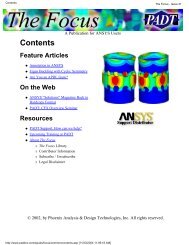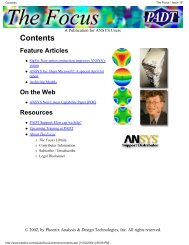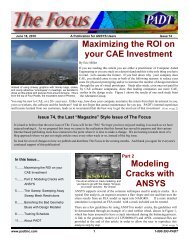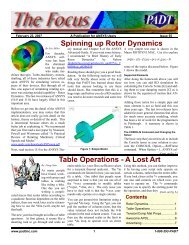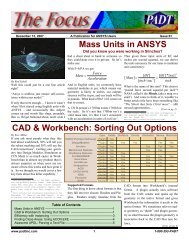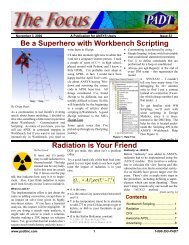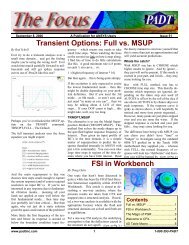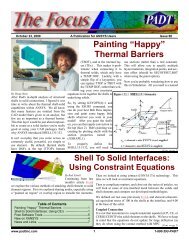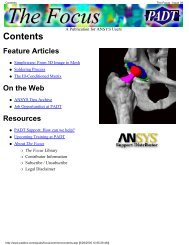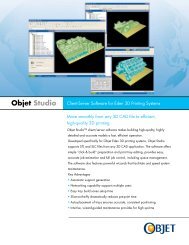The Focus - Issue 12 - PADT
The Focus - Issue 12 - PADT
The Focus - Issue 12 - PADT
Create successful ePaper yourself
Turn your PDF publications into a flip-book with our unique Google optimized e-Paper software.
Contents<br />
<strong>The</strong> <strong>Focus</strong> - <strong>Issue</strong> <strong>12</strong><br />
Contents<br />
A Publication for ANSYS Users<br />
Feature Articles<br />
●<br />
●<br />
●<br />
Programming with Tcl/Tk in ANSYS<br />
Restarting an ANSYS Run<br />
Testing Elastomers for ANSYS<br />
On the Web<br />
●<br />
●<br />
ANSYS Releases Variational Design<br />
Technology<br />
ANSYS 7.0 New Features<br />
Resources<br />
●<br />
●<br />
●<br />
●<br />
<strong>PADT</strong> Support: How can we help?<br />
Upcoming Training at <strong>PADT</strong><br />
About <strong>The</strong> <strong>Focus</strong><br />
❍ <strong>The</strong> <strong>Focus</strong> Library<br />
❍ Contributor Information<br />
❍ Subscribe / Unsubscribe<br />
❍ Legal Disclaimer<br />
Next in <strong>The</strong> <strong>Focus</strong><br />
© 2002, by Phoenix Analysis & Design Technologies, Inc. All rights reserved.<br />
http://www.padtinc.com/epubs/focus/common/contents.asp [11/23/2004 4:47:01 PM]
Programming with Tcl/Tk in ANSYS<br />
<strong>The</strong> <strong>Focus</strong> - <strong>Issue</strong> <strong>12</strong><br />
Programming with Tcl/Tk in<br />
ANSYS<br />
by Matt Sutton<br />
A Publication for ANSYS Users<br />
Introduction<br />
In this article we will explore programming with tcl/tk (pronounced tickle<br />
tee-kay) in ANSYS. Tcl, an acronym that stands for Tool Command Language, is<br />
an embedded programming language that was developed by John Ousterhout in<br />
the late 1980s while he was a professor at Berkeley. Initially, tcl grew out of a<br />
need for a simple, embeddable command language that Dr. Ousterhout and his<br />
colleagues could reuse within different integrated circuit design tools that they<br />
were developing at the time [1]. In a recent article, Dr. Ousterhout outlined the<br />
requirements he had in mind when he created tcl.<br />
<strong>The</strong> notion of embeddability is one of the most unique aspects of Tcl, and it led<br />
me to the following three overall goals for the language:<br />
● <strong>The</strong> language must be extensible: it must be very easy for each application<br />
http://www.padtinc.com/epubs/focus/2002/00<strong>12</strong>_1<strong>12</strong>5/article1.htm (1 of 11) [11/23/2004 4:47:52 PM]
Programming with Tcl/Tk in ANSYS<br />
<strong>The</strong> <strong>Focus</strong> - <strong>Issue</strong> <strong>12</strong><br />
A Publication for ANSYS Users<br />
●<br />
●<br />
to add its own features to the basic features of the language, and the<br />
application-specific features should appear natural, as if they had been<br />
designed into the language from the start.<br />
<strong>The</strong> language must be very simple and generic, so that it can work easily<br />
with many different applications and so that it doesn't restrict the features<br />
that applications can provide.<br />
Since most of the interesting functionality will come from the application,<br />
the primary purpose of the language is to integrate or glue together the<br />
extensions. Thus the language must have good facilities for integration. [1]<br />
Shortly after developing tcl, Dr. Ousterhouts interests shifted from integrated<br />
circuit design tools to graphical user interfaces (GUIs). At this time, again in the<br />
late 1980s, GUIs were still very much in their infancy. Furthermore, the<br />
manpower needed at that time to develop a usable GUI was rather substantial.<br />
Driven by a fear that his research team would be under staffed to tackle complex<br />
GUI development projects, Dr. Ousterhout realized that substantial interactive<br />
systems could be built out of smaller reusable components, which were then<br />
programmatically glued together. It was clear to Dr. Ousterhout that the tcl<br />
language would be ideal as the programmatic glue for such interactive systems,<br />
if only there existed a set of GUI components from which to build a system.<br />
Consequently, he begin developing tk in order to fulfill the need for a toolkit of<br />
reusable GUI components.<br />
Tcl/tk began to gain popularity throughout the software development community<br />
primarily via word-of-mouth. Today it is widely used throughout a plethora of<br />
industries largely because the source code for the tcl interpreter is freely available<br />
for download from the internet [2].<br />
Furthermore, the 5.7 release of ANSYS marked a substantial advancement of tcl<br />
within ANSYS. Within the 5.7 release, a fully functional tcl interpreter was<br />
exposed via the ~eui external command. Each subsequent release of ANSYS has<br />
continued to add functionality based on tcl/tk, culminating in the ANSYS 6.1<br />
release in which the new GUI is completely implemented with tcl/tk.<br />
<strong>The</strong> remainder of this article focuses on programming with tcl/tk in ANSYS. We<br />
will first briefly look at the tcl language and the tk toolkit in a generic sense. <strong>The</strong>n<br />
we will explore ways in which programs written in tcl can be written to interface<br />
directly with ANSYS. Finally, we will wrap up some loose ends and discuss a few<br />
of the more advanced aspects of tcl that help mitigate complexity in large<br />
projects.<br />
http://www.padtinc.com/epubs/focus/2002/00<strong>12</strong>_1<strong>12</strong>5/article1.htm (2 of 11) [11/23/2004 4:47:52 PM]
Programming with Tcl/Tk in ANSYS<br />
<strong>The</strong> <strong>Focus</strong> - <strong>Issue</strong> <strong>12</strong><br />
A Publication for ANSYS Users<br />
<strong>The</strong> Tcl/Tk Programming Language<br />
Tcl is an interpreted command language, and as such, requires an external piece<br />
of software known as the interpreter, which executes a tcl program stored in a text<br />
file. Outside of ANSYS, two interpreters are widely used: tclsh and wish. Tclsh<br />
simply implements the core tcl language, whereas wish extends the tclsh<br />
interpreter by natively exposing the tk toolkit. <strong>The</strong>refore, GUI applications written<br />
outside of ANSYS should be executed using the wish interpreter. Since wish is a<br />
superset of tclsh, it can be used exclusively if desired. Inside of ANSYS, the<br />
equivalent of a wish interpreter is provided by the ~eui external command. Since<br />
this article focuses on tcl/tk within ANSYS, we will execute all of the example<br />
programs from within ANSYS via the ~eui command. However, I have often<br />
found that I am more productive initially if I begin developing a new application<br />
outside of ANSYS using an off the shelf tcl interpreter [2]. Only after the<br />
application is functioning correctly do I typically move into ANSYS.<br />
Lets begin with the prototypical example application used to introduce all<br />
modern programming languages; the Hello World app. Please follow the steps<br />
below to create this application.<br />
1. Launch ANSYS and note the working directory.<br />
2. Launch you favorite text editor and type in the listing shown in Figure 1.<br />
Tcl is case sensitive and somewhat non-freeform. <strong>The</strong>refore it is imperative<br />
that you type the program in exactly as it is listed in Figure 1.<br />
3. Save this file in the current ANSYS working directory with the name<br />
hello1.tcl<br />
4. Execute this script in ANSYS using the ANSYS command listed at the<br />
bottom of Figure 2.<br />
proc HelloWorld1 {} {<br />
puts Hello World!<br />
}<br />
HelloWorld1<br />
Figure 1. First "Hello World" application.<br />
~eui, source [file join [pwd] hello1.tcl]<br />
http://www.padtinc.com/epubs/focus/2002/00<strong>12</strong>_1<strong>12</strong>5/article1.htm (3 of 11) [11/23/2004 4:47:52 PM]
Programming with Tcl/Tk in ANSYS<br />
<strong>The</strong> <strong>Focus</strong> - <strong>Issue</strong> <strong>12</strong><br />
A Publication for ANSYS Users<br />
Figure 2. Command to execute a tcl script within ANSYS that is located in the<br />
current working directory.<br />
Follow these steps and you should see the string Hello World! printed in the<br />
ANSYS output window.<br />
As you can see, tcl has a syntax that is very similar to the C programming<br />
language. It is a structured, procedural language that has a rich set of control<br />
structures. <strong>The</strong> first line in our example program declares a procedure named<br />
HelloWorld1. Procedures in tcl are analogous to functions in C or subroutines<br />
in FORTRAN. <strong>The</strong> second line calls a built-in tcl procedure named puts which<br />
prints a string to the standard output. <strong>The</strong> third line contains the closing brace for<br />
the procedure, and the final line simply calls the procedure named HelloWorld1.<br />
You will notice that there is no main function. In fact, execution in tcl begins with<br />
the first executable statement, which in this case is the last line. Consequently,<br />
this program could have simply been written using a single line: puts Hello<br />
World!<br />
<strong>The</strong> fundamental data type in tcl is the string. Consequently, all variables used in<br />
a tcl program are represented within the tcl interpreter as strings. This provides a<br />
great deal of flexibility at a small cost in performance. Remember, however, tcl is<br />
not intended to be a computational workhorse, but rather a glue language, so the<br />
performance hit for typical glue code should be negligible. <strong>The</strong> second most<br />
common data type in tcl is the list. Internally, a list is stored within tcl as a special<br />
kind of string. A list allows you to effortlessly manipulate a collection of data.<br />
Before we move to the next example there is one last concept regarding variables<br />
that needs to be mentioned, that is the concept of scope. Variables within tcl can<br />
live within one of two scopes: the local or global scope. (Tcl namespaces add an<br />
additional scope, however, namespaces will not be discussed in this article.) <strong>The</strong><br />
following example demonstrates the concept of local and global variables as well<br />
as lists and function arguments.<br />
proc Hello2 {People} {<br />
global Salutation<br />
foreach Person $People {<br />
puts Hello $Person<br />
}<br />
set NumberOfPeople [llength $People]<br />
if { $NumberOfPeople > 1 } {<br />
puts I said hello to $NumberOfPeople people.<br />
http://www.padtinc.com/epubs/focus/2002/00<strong>12</strong>_1<strong>12</strong>5/article1.htm (4 of 11) [11/23/2004 4:47:52 PM]
Programming with Tcl/Tk in ANSYS<br />
<strong>The</strong> <strong>Focus</strong> - <strong>Issue</strong> <strong>12</strong><br />
} else {<br />
puts I said hello to one person.<br />
}<br />
puts $Salutation<br />
}<br />
set Salutation Good-bye!<br />
Hello2 [list Fred Jane Bob]<br />
Figure 3. Second "Hello" application.<br />
To execute the code in Figure 3, follow the same steps mentioned above.<br />
However, save the code in Figure 3 with the name hello2.tcl. Substitute the file<br />
name hello2.tcl for hello1.tcl in the command given in Figure 2. You should see<br />
the following output in the ANSYS output window:<br />
Hello Fred<br />
Hello Jane<br />
Hello Bob<br />
I said hello to 3 people.<br />
Good-bye!<br />
Figure 4. Output from hello2.tcl.<br />
<strong>The</strong> example program in Figure 3 is somewhat more substantial, but it succinctly<br />
demonstrates many of the features of tcl. Most of the programmatic constructs<br />
should be familiar except perhaps the foreach construct. <strong>The</strong> foreach construct is<br />
used to iterate over the contents of a tcl list. <strong>The</strong> list is passed into the function<br />
Hello2 via the People variable. <strong>The</strong> global variable, Salutation is set to<br />
Good-bye! outside of the procedure Hello2 on the second to last line.<br />
In the next example, we will use the tk toolkit to create a simple GUI. <strong>The</strong> GUI<br />
will consist of a single button that, when pressed, will invoke the Hello2<br />
procedure shown in Figure 3. Figure 4 shows the code.<br />
destroy .tplvl<br />
set t [toplevel .tplvl]<br />
set b1 [button .tplvl.b1 command Hello2 Jim \<br />
text Say Hello ]<br />
pack $b1<br />
proc Hello2 {People} {<br />
global Salutation<br />
A Publication for ANSYS Users<br />
http://www.padtinc.com/epubs/focus/2002/00<strong>12</strong>_1<strong>12</strong>5/article1.htm (5 of 11) [11/23/2004 4:47:52 PM]
Programming with Tcl/Tk in ANSYS<br />
<strong>The</strong> <strong>Focus</strong> - <strong>Issue</strong> <strong>12</strong><br />
foreach Person $People {<br />
puts Hello $Person<br />
}<br />
set NumberOfPeople [llength $People]<br />
if { $NumberOfPeople > 1 } {<br />
puts I said hello to $NumberOfPeople people.<br />
} else {<br />
puts I said hello to one person.<br />
}<br />
puts $Salutation<br />
}<br />
set Salutation Good-bye!<br />
Figure 5. Second "Hello" application.<br />
A Publication for ANSYS Users<br />
Again, to execute this code, follow the procedure outlined above. However, save<br />
this file as hello3.tcl and change the ~eui command listed in Figure 2 accordingly.<br />
You should see the following window on your screen.<br />
Figure 6. Tk window for the example in Figure 5.<br />
Lets analyze the first five lines in Figure 5 since they are different from the code<br />
in Figure 4. <strong>The</strong> first two lines are necessary when programming in tcl/tk within<br />
ANSYS. <strong>The</strong> first line destroys any previous instance of the window shown in<br />
Figure 6. If no instance of this window exists, then the first line simply returns.<br />
<strong>The</strong> second line actually creates a new toplevel window into which we can add<br />
additional tk widgets to form the GUI for our application. We are implicitly<br />
storing the returned value from the toplevel call into the variable t.<br />
<strong>The</strong> tk toolkit uses an implicit hierarchical syntax to impose parent-child<br />
relationships between widgets. <strong>The</strong> root window of any tk application is<br />
referenced in the code as the . window. All other windows are children on the<br />
root window .. So, in Figure 5 on line two, we are creating a new toplevel<br />
window named tplvl whose parent is the root window .. This relationship is<br />
encoded in the name of the window, which is .tplvl. <strong>The</strong> encoding is analogous<br />
to the file structure used on most modern operating systems, especially UNIX.<br />
<strong>The</strong> separator for encoding the parent child relationship is the ..<br />
http://www.padtinc.com/epubs/focus/2002/00<strong>12</strong>_1<strong>12</strong>5/article1.htm (6 of 11) [11/23/2004 4:47:52 PM]
Programming with Tcl/Tk in ANSYS<br />
<strong>The</strong> <strong>Focus</strong> - <strong>Issue</strong> <strong>12</strong><br />
A Publication for ANSYS Users<br />
On the third and fourth lines we are creating a button that will be a child of the<br />
new toplevel window we just created. This is accomplished by encoding the<br />
parent child relationship into the name of the button. <strong>The</strong> name of the button is<br />
given as the first argument to the button command, which is .tplvl.b1. So,<br />
following the naming convention used by tk, we see that the button, b1, is a child<br />
of the toplevel window, tplvl, who is a child of the root window . This<br />
parent-child relationship insures that when the window shown in Figure 6. is<br />
created by the tk toolkit, the button will appear inside the toplevel window.<br />
When you press the button, Say Hello, the tk toolkit will translate that event into<br />
a call to the procedure Hello2. This link between pressing a button and executing<br />
some tcl code is created via the command argument to the button function. As<br />
you can see on the third line in Figure 5, the command argument is followed by a<br />
string. This string contains the name of a procedure, Hello2, followed by<br />
arguments to that procedure. This creates the implicit link between the users<br />
action of pressing the button and a command that is executed.<br />
<strong>The</strong> fifth line in figure 5 contains the command pack $b1. As mentioned above,<br />
this command is responsible for placing the button onto the toplevel window. <strong>The</strong><br />
pack command in tk works much like packing a box with smaller rectangular<br />
items. Once all the items are packed, and just prior to displaying the window, the<br />
tk toolkit shrinks the outer box, in this case the toplevel window, around the<br />
smaller boxes so that all of the slack space is taken up. <strong>The</strong> packing mechanism is<br />
a powerful tool for placing widgets on a window because it allows the tk<br />
framework to reposition widgets on the screen as a window is resized.<br />
<strong>The</strong> tk toolkit provides two additional mechanisms for placing widgets on the<br />
screen. <strong>The</strong>y are the grid command and the place command. <strong>The</strong> grid command is<br />
similar in power to the pack command. It differs slightly in methodology in that it<br />
allows you to place widgets into cells within a virtual grid that overlays a<br />
window. A powerful feature of the tk toolkit is that both the pack and grid<br />
commands can be use in conjunction within the same window. Furthermore, by<br />
exploiting the hierarchical nature of tk, along with certain grouping widgets like<br />
the frame widget, extremely complex user interfaces can be constructed. Though<br />
a detailed discussion of such techniques is beyond the scope of this article,<br />
additional information on these commands can be found in references 3, 4 and 5.<br />
<strong>The</strong> tk toolkit has a substantial assortment of standard widgets. In addition,<br />
several free add-on packages such as Bwidgets, Iwidgets, incr tcl, etc& exist<br />
which provide higher level GUI widgets. A list of the standard widgets is shown<br />
in Table 1.<br />
http://www.padtinc.com/epubs/focus/2002/00<strong>12</strong>_1<strong>12</strong>5/article1.htm (7 of 11) [11/23/2004 4:47:52 PM]
Programming with Tcl/Tk in ANSYS<br />
<strong>The</strong> <strong>Focus</strong> - <strong>Issue</strong> <strong>12</strong><br />
Widget Description<br />
button Creates a standard pushbutton<br />
canvas Creates a canvas on which graphic primitives can be drawn<br />
checkbuttonCreates a standard check button<br />
entry Creates a single line text entry box<br />
frame Creates a virtual frame useful for grouping widgets<br />
label Creates a static text label<br />
listbox Creates a standard list box<br />
menu Creates either a popup menu or a standard application menu<br />
menubuttonCreates a menu item with an associated on/off state<br />
message Creates a small message window<br />
radiobutton Creates a standard exclusive radio button<br />
scale Creates a sliding scale control<br />
scrollbar Creates a standard scroll bar<br />
text Creates a multi-line text widget with extensive formatting capabilities<br />
toplevel Creates a new toplevel window into which widgets can be placed<br />
Table 1. Standard tk widgets.<br />
A Publication for ANSYS Users<br />
Programming Tcl/tk in ANSYS Just<br />
think APDL<br />
Now that we have introduced tcl/tk in a generic sense, we next move to writing a<br />
small tcl/tk application that interacts directly with ANSYS. This application will<br />
simply create a node at a given location in the x-y plane. As you will see,<br />
interacting with ANSYS through tcl is extremely straightforward. In a nutshell,<br />
you simply construct APDL commands as strings within tcl and then send them to<br />
ANSYS. Consider the code shown in Figure 7.<br />
destroy .tplvl<br />
set t [toplevel .tplvl]<br />
wm title $t Create Node<br />
set xLab [label $t.lx text X:]<br />
set yLab [label $t.ly text Y:]<br />
set xEntry [entry $t.ex textvariable x]<br />
set yEntry [entry $t.ey textvariable y]<br />
set b1 [button $t.b1 command CreateNode \<br />
text Create Node ]<br />
grid $xLab row 0 column 0<br />
grid $xEntry row 0 column 1<br />
http://www.padtinc.com/epubs/focus/2002/00<strong>12</strong>_1<strong>12</strong>5/article1.htm (8 of 11) [11/23/2004 4:47:52 PM]
Programming with Tcl/Tk in ANSYS<br />
<strong>The</strong> <strong>Focus</strong> - <strong>Issue</strong> <strong>12</strong><br />
A Publication for ANSYS Users<br />
grid $yLab row 1 column 0<br />
grid $yEntry row 1 column 1<br />
grid $b1 row 2 column 0 columnspan 2<br />
proc CreateNode {} {<br />
global x y<br />
set NextNode [ans_getvalue NODE,0,NUM,MAXD]<br />
ans_sendcommand /prep7<br />
ans_sendcommand n,$NextNode,$x,$y<br />
}<br />
Figure 7. Application to create a node in ANSYS.<br />
To execute the code shown in Figure 7, enter the text into a text file named<br />
createnode.tcl and save this file in the current ANSYS working directory. Next<br />
issue the command shown in Figure 2 substituting createnode.tcl for hello1.tcl.<br />
When this code is executed a window resembling the one shown in Figure 8<br />
should appear.<br />
Figure 8. Create node dialog.<br />
<strong>The</strong> interesting code in this example is contained within the CreateNode<br />
procedure. All of the code above the CreateNode procedure is responsible for<br />
creating and displaying the various widgets within the dialog box. Please refer to<br />
the previous section to gain an overview of what this code does. [3,4,5]<br />
<strong>The</strong> CreateNode procedure is called whenever the button Create Node is pressed.<br />
<strong>The</strong> first line within this procedure declares two variables, x and y, as global<br />
variables. <strong>The</strong>se variables are attached to the two entry boxes adjacent to the X:<br />
and Y: labels. Whenever a user enters a number into one of the text boxes, the tk<br />
toolkit updates the corresponding variable to contain the value entered by the<br />
user. By declaring these variables as global variables in the procedure<br />
CreateNode, we gain access to the values that the user typed into the two entry<br />
boxes.<br />
http://www.padtinc.com/epubs/focus/2002/00<strong>12</strong>_1<strong>12</strong>5/article1.htm (9 of 11) [11/23/2004 4:47:52 PM]
Programming with Tcl/Tk in ANSYS<br />
<strong>The</strong> <strong>Focus</strong> - <strong>Issue</strong> <strong>12</strong><br />
A Publication for ANSYS Users<br />
<strong>The</strong> next line in the CreateNode procedure creates a local variable named<br />
NextNode. This variable stores the result from a call to a procedure named<br />
ans_getvalue. <strong>The</strong> ans_getvalue procedure is the first of the two primary<br />
procedures used to communicate with ANSYS via tcl. This procedure mimics the<br />
*GET APDL command. In fact, the single argument to the ans_getvalue<br />
procedure is a string containing fields 3 through 8 of the *GET command in<br />
comma delimited format. <strong>The</strong>refore, any parameter from an ANSYS database that<br />
is accessible via the *GET APDL command can also be accessed and stored in a<br />
tcl variable via the ans_getvalue procedure. So, by interpreting the argument as a<br />
*GET command, we see that we are simply asking ANSYS to return the next<br />
higher node number not yet defined in the database. We will then use this number<br />
to create a unique node at a given position.<br />
<strong>The</strong> next two lines in the CreateNode procedure are calls to a function named<br />
ans_sendcommand. This is the second of the two primary procedures used to<br />
communicate with ANSYS. As mentioned above, the first procedure,<br />
ans_getvalue, is used to extract data from the ANSYS database. <strong>The</strong><br />
ans_sendcommand procedure, however, is the compliment of the ans_getvalue<br />
procedure. This procedure is used to send specific APDL commands to ANSYS.<br />
<strong>The</strong> single argument to this function is a string comprising a valid APDL<br />
command. As you can see, the first call to ans_sendcommand sends the /prep7<br />
command to ANSYS to force ANSYS to enter the preprocessor. <strong>The</strong> second call<br />
to the ans_sendcommand is more interesting. This call constructs, via variable<br />
substitution, an ANSYS command to create a node. As you can see, we build up<br />
the command by substituting the value of the NextNode variable into the second<br />
field of the ANSYS N command, and then the value of the x and y variables into<br />
the subsequent fields of the N command.<br />
So, as an example, lets say there are no nodes currently defined in the database.<br />
<strong>The</strong> user types 0.5 into the X: entry and 1.5 into the Y: entry and then presses<br />
the Create Node button. This causes the CreateNode procedure to be called.<br />
When the call to ans_getvalue is executed, a return value of 1 is stored in the<br />
NextNode variable since no nodes are currently defined in the database. <strong>The</strong> tk<br />
toolkit has already stored 0.5 in the x variable and 1.5 in y variable. Since we<br />
declared these variables as global, we have access to their values within the<br />
CreateNode procedure. So, when the second call to ans_sendcommand is<br />
executed, the tcl interpreter substitutes the values for these three variables into the<br />
procedure argument before passing control to the ans_sendcommand. This<br />
variable substitution results in a string equal to n,1,0.5,1.5. <strong>The</strong><br />
ans_sendcommand then takes this string and feeds it to the ANSYS APDL<br />
http://www.padtinc.com/epubs/focus/2002/00<strong>12</strong>_1<strong>12</strong>5/article1.htm (10 of 11) [11/23/2004 4:47:52 PM]
Programming with Tcl/Tk in ANSYS<br />
<strong>The</strong> <strong>Focus</strong> - <strong>Issue</strong> <strong>12</strong><br />
command interpreter. Finally, the command interpreter executes this command<br />
just as if you had typed it into the command window. <strong>The</strong> result then is a new<br />
node at the location specified by the user.<br />
Conclusion<br />
Weve covered quite a bit of information in this article culminating in a<br />
description of how the tcl programming language interfaces with ANSYS.<br />
However, the key idea when programming in tcl for ANSYS was shown to be<br />
quite simple; that is Just think APDL. By using a combination of the<br />
ans_getvalue and ans_sendcommand procedures along with the tk toolkit,<br />
complex, highly interactive, and visually pleasing applications can be created<br />
within ANSYS that customize its functionality for a given process. Though we<br />
have covered a substantial amount of territory in this article, weve really only<br />
highlighted a few aspects of programming in tcl. Hopefully, this introduction has<br />
successfully whetted youre appetite for programming in tcl within ANSYS. If so,<br />
I suggest that you peruse through the references sited at the end of this article to<br />
become more grounded in tcl/tk programming.<br />
References<br />
A Publication for ANSYS Users<br />
[1] www.tcl.tk/doc/tclHistory.html<br />
[2] www.activestate.com/Solutions/Programmer/Tcl.plex<br />
[3] Raines, P. & J. Tranter, Tcl/Tk in a Nutshell, OReilly, 1999<br />
[4] Harrison, M. & M. McLennan, Effective Tcl/Tk Programming,<br />
Addison-Wesley, 1998.<br />
[5] Foster-Johnson, E., Graphical Applications with Tcl/Tk, M&T Books, 2/ed,<br />
1997.<br />
http://www.padtinc.com/epubs/focus/2002/00<strong>12</strong>_1<strong>12</strong>5/article1.htm (11 of 11) [11/23/2004 4:47:52 PM]
Restarting an ANSYS Run<br />
<strong>The</strong> <strong>Focus</strong> - <strong>Issue</strong> <strong>12</strong><br />
Restarting an ANSYS Run<br />
by Ted Harris<br />
A Publication for ANSYS Users<br />
Youve just run your deflection analysis and checked the results, only to realize that you<br />
forgot a load step. Or you just ran a contact analysis but found that your contact stiffness<br />
was too low. Another possibility is that you ran your nonlinear analysis and it converged<br />
for part of the load but not all of the load. Do you have to rerun the whole thing to fix it?<br />
<strong>The</strong> answer is, No, because you can perform a restart analysis to pick up where you left<br />
off.<br />
ANSYS always allows you to restart from the last converged substep of the last load<br />
step, or in other words from the last set of good results in your model. Additionally, with<br />
some foresight you can have ANSYS create restart files at certain intervals in your<br />
analysis. Restarts can be performed for any of the time points for which these restart files<br />
have been written.<br />
<strong>The</strong> original type of restart in ANSYS is called a single-frame restart. This allows us to<br />
restart from the last converged solution. <strong>The</strong> single-frame restart requires a .db file saved<br />
in the same state as when the solution was initiated, the .emat file, if created, the .tri file<br />
if the frontal solver is being used, and the .esav or .osav files. Note that if your solution<br />
does not converge, ANSYS will automatically save the .db file for you.<br />
<strong>The</strong> newer type of restart, the multi-frame restart, made its debut in ANSYS 5.6. This<br />
allows us to specify multiple restart points, if desired. To modify the behavior from the<br />
default, which is to allow a restart from the last converged substep, we utilize the<br />
RESCONTROL command. RECONTROL is available in the GUI through the solution<br />
controls dialog box (Main Menu > Solution > Analysis Type > Soln Controls). <strong>The</strong><br />
right side of the Soln Options tab contains the input fields for the RESCONTROL<br />
command.<br />
http://www.padtinc.com/epubs/focus/2002/00<strong>12</strong>_1<strong>12</strong>5/article2.htm (1 of 4) [11/23/2004 4:47:52 PM]
Restarting an ANSYS Run<br />
<strong>The</strong> <strong>Focus</strong> - <strong>Issue</strong> <strong>12</strong><br />
A Publication for ANSYS Users<br />
We have the option to specify a total number of restart files to write, as well as a<br />
frequency at which they will be written, such as every third substep. Note that by default,<br />
only a single set of restart files will be written, for the last converged substep of the last<br />
load step.<br />
<strong>The</strong> files used in a multi-frame restart are the jobname.rdb file, which is a version of the<br />
.db file that has been automatically saved in the state the database was in at the start of<br />
the solution, the jobname.ldhi file, which contains the load history, and the jobname.rnnn<br />
file(s), which contain element saved data and solution settings for each restart point.<br />
<strong>The</strong>se last files will have names of jobname.r001 for the first restart point, jobname.r002<br />
for the second restart point, etc.<br />
In order to perform a restart, we must have left the solution module since the last solution<br />
was completed. Otherwise, ANSYS thinks we want to continue with a subsequent load<br />
step. An exception is an unconverged solution, from which a restart can be initiated<br />
while still in the solution module.<br />
In most cases we will be doing a multi-frame restart, even if from the last converged<br />
substep, because this is the default behavior in ANSYS.<br />
To restart an analysis, we click on Main Menu > Analysis Type > Restart. <strong>The</strong><br />
following image shows a typical result of performing that operation:<br />
http://www.padtinc.com/epubs/focus/2002/00<strong>12</strong>_1<strong>12</strong>5/article2.htm (2 of 4) [11/23/2004 4:47:52 PM]
Restarting an ANSYS Run<br />
<strong>The</strong> <strong>Focus</strong> - <strong>Issue</strong> <strong>12</strong><br />
A Publication for ANSYS Users<br />
<strong>The</strong> white listing window shows us the available restart points for our analysis. In the<br />
case shown, we have a single restart point at load step 1, sub step 7. This corresponds to<br />
time 0.8 of our solution. We input the load step and sub step numbers for the desired<br />
restart point into the grey window, as shown. <strong>The</strong> action continue means that our<br />
analysis will attempt to progress with the solution. <strong>The</strong> other available actions are, end<br />
load step, and create results file. Typically we want our analysis to continue.<br />
<strong>The</strong> procedure to do a restart analysis is as follows:<br />
1. If you are still in ANSYS, leave the solution module and return to it by entering<br />
FINISH and then /SOLU or click on Main Menu > Finish or Main Menu ><br />
General Postproc and then return to Main Menu > Solution.<br />
2. Specify a restart analysis by issuing ANTYPE,,REST (Main Menu > Solution ><br />
Restart).<br />
3. Make the changes necessary to the loads, boundary conditions, solution options,<br />
etc. for the restart. For example, you can increase the number of substeps to<br />
enhance the convergence process, or change the loads to model a different loading<br />
condition.<br />
http://www.padtinc.com/epubs/focus/2002/00<strong>12</strong>_1<strong>12</strong>5/article2.htm (3 of 4) [11/23/2004 4:47:52 PM]
Restarting an ANSYS Run<br />
<strong>The</strong> <strong>Focus</strong> - <strong>Issue</strong> <strong>12</strong><br />
A Publication for ANSYS Users<br />
4.<br />
5.<br />
In case you used the Frontal solver (not the default), specify whether the<br />
triangularized matrix, jobname.tri, will be reused. See the documentation on the<br />
KUSE command for more information.<br />
Initiate the restart solution by issuing the SOLVE command. (Main Menu ><br />
Solution > Solve > Current LS).<br />
At this point, the solution will continue. Any results sets on the results file for load<br />
step/sub step/time points after the specified restart point will be deleted. If the restart<br />
solution is successful, new results sets will be added to the results file at the appropriate<br />
load step/sub step/time point indices.<br />
By default ANSYS will utilize the multi-frame restart files, which again will allow us to<br />
at least perform a restart from the last converged substep of the last load step. We can use<br />
RESCONTROL prior to the initiation of our first solution to specify more restart points.<br />
<strong>The</strong> drawback in specifying lots of restart points is that our restart files will take up more<br />
and more room on our hard disk.<br />
Note that for surface to surface contact elements, we must set KEYOPT(10) to 1 or 2 in<br />
order for the contact stiffness, FKN, to be changed between load steps or in a restart.<br />
This step is no longer necessary in ANSYS 7.0, however.<br />
An additional capability of the multi-frame restart is to add results sets to the results file.<br />
This can be done for load step/sub step/time points for which restart files have been<br />
written but for which no results were initially written to the results file.<br />
Restarts are useful in allowing us to explore a different load history than we originally<br />
planned as well as in recovering from an unconverged solution. We can hopefully make<br />
changes to our model to get a converged solution without having to run the entire<br />
solution again.<br />
More information can be found in the on-line Help System, in the Basic Analysis<br />
Procedures Guide, Section 3.16, entitled Restarting an Analysis.<br />
http://www.padtinc.com/epubs/focus/2002/00<strong>12</strong>_1<strong>12</strong>5/article2.htm (4 of 4) [11/23/2004 4:47:52 PM]
Testing Elastomers for ANSYS<br />
<strong>The</strong> <strong>Focus</strong> - <strong>Issue</strong> <strong>12</strong><br />
Testing Elastomers for ANSYS<br />
by Kurt Miller of Axel Products, Inc.<br />
Introduction<br />
A Publication for ANSYS Users<br />
<strong>The</strong> objective of the testing described herein is to define and to satisfy the input<br />
requirements of mathematical material models for elastomers that exist in<br />
ANSYS.<br />
<strong>The</strong> testing of elastomers for the purpose of defining material models is often<br />
misunderstood. <strong>The</strong> appropriate experiments are not yet clearly defined by<br />
national or international standards organizations. This difficulty derives from the<br />
complex mathematical models that are required to define the nonlinear and the<br />
nearly incompressible attributes of elastomers.<br />
Most of these models are referred to as hyperelastic material models and they<br />
include Mooney-Rivlin and Ogden models. However, most models share common<br />
test data input requirements. In general, stress and strain data sets developed by<br />
stretching the elastomer in several modes of deformation are required and fitted<br />
to sufficiently define the variables in the material models. A typical set of 3 stress<br />
strain curves appropriate for input into fitting routines is shown is shown in<br />
Figure 1.<br />
http://www.padtinc.com/epubs/focus/2002/00<strong>12</strong>_1<strong>12</strong>5/article3.htm (1 of 9) [11/23/2004 4:47:53 PM]
Testing Elastomers for ANSYS<br />
<strong>The</strong> <strong>Focus</strong> - <strong>Issue</strong> <strong>12</strong><br />
A Publication for ANSYS Users<br />
Figure 1. A Typical Final Data Set for Input into the ANSYS Curve Fitter.<br />
Testing in Multiple Strain States<br />
<strong>The</strong> modes of deformation each put the material into a particular state of strain.<br />
One objective of testing is to achieve pure states of strain such that the stress<br />
strain curve represents the elastomer behavior only in the desired state. <strong>The</strong><br />
purpose of fitting multiple states of strain rather than just tension is that<br />
hyperelastic material models may easily create non-physical results in strain states<br />
not represented in the experimental data.<br />
For incompressible elastomers, the basic strain states are simple tension, pure<br />
shear and equal biaxial extension. For slightly compressible situations or<br />
situations where an elastomer is highly constrained, a volumetric compression test<br />
may be needed to determine the bulk behavior.<br />
Simple Tension Strain State<br />
<strong>The</strong> most significant requirement for simple tension is that in order to achieve a<br />
state of pure tensile strain, the specimen must be much longer in the direction of<br />
stretching than in the width and thickness dimensions. <strong>The</strong> objective is to create<br />
an experiment where there is no lateral constraint to specimen thinning. A<br />
non-contacting strain measuring device such as a video extensometer or laser<br />
extensometer is required to measure strain where the pure strain condition exists.<br />
http://www.padtinc.com/epubs/focus/2002/00<strong>12</strong>_1<strong>12</strong>5/article3.htm (2 of 9) [11/23/2004 4:47:53 PM]
Testing Elastomers for ANSYS<br />
<strong>The</strong> <strong>Focus</strong> - <strong>Issue</strong> <strong>12</strong><br />
A Publication for ANSYS Users<br />
Figure 2. A Tension Experiment using a Video Extensometer.<br />
Pure Shear Strain State<br />
<strong>The</strong> pure shear experiment used for analysis is not what most of us would expect.<br />
<strong>The</strong> experiment appears at first glance to be nothing more than a very wide tensile<br />
test. However, because the material is nearly incompressible, a state of pure shear<br />
exists in the specimen at a 45-degree angle to the stretching direction. <strong>The</strong> most<br />
significant aspect of the specimen is that it is much shorter in the direction of<br />
stretching than the width. <strong>The</strong> objective is to create an experiment where the<br />
specimen is perfectly constrained in the lateral direction such that all specimen<br />
thinning occurs in the thickness direction.<br />
http://www.padtinc.com/epubs/focus/2002/00<strong>12</strong>_1<strong>12</strong>5/article3.htm (3 of 9) [11/23/2004 4:47:53 PM]
Testing Elastomers for ANSYS<br />
<strong>The</strong> <strong>Focus</strong> - <strong>Issue</strong> <strong>12</strong><br />
A Publication for ANSYS Users<br />
Figure 3. A Pure Shear Experiment using a Laser Extensometer.<br />
Equal Biaxial Strain State<br />
For incompressible or nearly incompressible materials, equal biaxial extension of<br />
a specimen creates a state of strain equivalent to pure compression. Although the<br />
actual experiment is more complex than the simple compression experiment, a<br />
pure state of strain can be achieved which will result in a more accurate material<br />
model. <strong>The</strong> equal biaxial strain state may be achieved by radial stretching a<br />
circular disc.<br />
http://www.padtinc.com/epubs/focus/2002/00<strong>12</strong>_1<strong>12</strong>5/article3.htm (4 of 9) [11/23/2004 4:47:53 PM]
Testing Elastomers for ANSYS<br />
<strong>The</strong> <strong>Focus</strong> - <strong>Issue</strong> <strong>12</strong><br />
A Publication for ANSYS Users<br />
Figure 4. A Biaxial Extension Experiment.<br />
Volumetric Compression<br />
Volumetric compression is an experiment where the compressibility of the<br />
material is examined. In this experiment, a cylindrical specimen is constrained in<br />
a fixture and compressed. <strong>The</strong> actual displacement during compression is very<br />
small and great care must be taken to measure only the specimen compliance and<br />
not the stiffness of the instrument itself. <strong>The</strong> initial slope of the resulting<br />
stress-strain function is the bulk modulus. This value is typically 2-3 orders of<br />
magnitude greater than the shear modulus for elastomers.<br />
Using Slow Cyclic Loadings to Create<br />
Stress Strain Curves<br />
<strong>The</strong> structural properties of elastomers change significantly during the first<br />
several times that the material experiences straining. This behavior is commonly<br />
referred to as the Mullins effect. If an elastomer is loaded to a particular strain<br />
http://www.padtinc.com/epubs/focus/2002/00<strong>12</strong>_1<strong>12</strong>5/article3.htm (5 of 9) [11/23/2004 4:47:53 PM]
Testing Elastomers for ANSYS<br />
<strong>The</strong> <strong>Focus</strong> - <strong>Issue</strong> <strong>12</strong><br />
A Publication for ANSYS Users<br />
level followed by complete unloading to zero stress several times, the change in<br />
structural properties from cycle to cycle as measured by the stress strain function<br />
will diminish. When the stress strain function no longer changes significantly, the<br />
material may be considered to be stable for strain levels below that particular<br />
strain maximum.<br />
If the elastomer is then taken to a new higher strain maximum, the structural<br />
properties will again change significantly. One example of this behavior is shown<br />
in Figure 5 where an elastomers is strained to 20% strain for 10 repetitions<br />
followed by straining to 50% for 10 repetitions and followed by straining to 100%<br />
for 10 repetitions.<br />
Figure 5. Multiple Strain Cycles of an Elastomer at 3 Maximum Strain Levels.<br />
Observations<br />
Several observations can be made regarding this behavior that is true to a varying<br />
degree for all elastomers.<br />
1. <strong>The</strong> stress strain function for the 1st time an elastomer is strained is never<br />
again repeated. It is a unique event.<br />
http://www.padtinc.com/epubs/focus/2002/00<strong>12</strong>_1<strong>12</strong>5/article3.htm (6 of 9) [11/23/2004 4:47:53 PM]
Testing Elastomers for ANSYS<br />
<strong>The</strong> <strong>Focus</strong> - <strong>Issue</strong> <strong>12</strong><br />
A Publication for ANSYS Users<br />
2.<br />
3.<br />
4.<br />
5.<br />
<strong>The</strong> stress strain function does stabilize after between 3 and 20 repetitions<br />
for most elastomers.<br />
<strong>The</strong> stress strain function will again change significantly if the material<br />
experiences strains greater than the previous stabilized level. In general, the<br />
stress strain function is sensitive to the maximum strain ever experienced.<br />
<strong>The</strong> stress strain function of the material while increasing strain is different<br />
than the stress strain function of the material while decreasing strain.<br />
After the initial straining, the material does not return to zero strain at zero<br />
stress. <strong>The</strong>re is some degree of permanent deformation.<br />
Limitations of Hyperelastic Material<br />
Models<br />
Most material models in commercially available finite element analysis codes<br />
allow the analyst to describe only a subset of the structural properties of<br />
elastomers. This discussion revolves around hyperelastic material models such as<br />
the Mooney-Rivlin and Ogden formulations and relates to those issues which<br />
effect testing.<br />
1. <strong>The</strong> stress strain functions in the model are stable. <strong>The</strong>y do not change with<br />
repetitive loading. <strong>The</strong> material model does not differentiate between a 1st<br />
time strain and a 100th time straining of the part under analysis.<br />
2. <strong>The</strong>re is no provision to alter the stress strain description in the material<br />
model based on the maximum strains experienced.<br />
3. <strong>The</strong> stress strain function is fully reversible so that increasing strains and<br />
decreasing strains use the same stress strain function. Loading and<br />
unloading the part under analysis is the same.<br />
4. <strong>The</strong> models treat the material as perfectly elastic meaning that there is no<br />
provision for permanent strain deformation. Zero stress is always zero<br />
strain.<br />
<strong>The</strong> Need for Judgment<br />
Because the models use a simple reversible stress strain input, one must input a<br />
stress strain function that is relevant to the to loading situation expected in the<br />
application. Naturally, this may be difficult because the very purpose of the<br />
http://www.padtinc.com/epubs/focus/2002/00<strong>12</strong>_1<strong>12</strong>5/article3.htm (7 of 9) [11/23/2004 4:47:53 PM]
Testing Elastomers for ANSYS<br />
<strong>The</strong> <strong>Focus</strong> - <strong>Issue</strong> <strong>12</strong><br />
A Publication for ANSYS Users<br />
analysis is to learn about the stress strain condition in the part. However, there are<br />
a few guidelines that may be considered.<br />
1. If the focus of the analysis is to examine the first time straining of an<br />
elastomeric part, then use the first time stress strain curves from material<br />
tests. This might be the case when examining the stresses experienced<br />
when installing a part for the first time.<br />
2. If the focus of the analysis is to understand the typical structural condition<br />
of a part in service, use stress strain curves derived by cycling a material<br />
until it is stable and extracting the stabilized increasing strain curve.<br />
3. If the focus of the analysis is to understand the unloading performance of a<br />
part in service by examining the minimum stress conditions, extract a<br />
stabilized decreasing strain curve.<br />
4. Perform experiments at strain levels that are reasonable for the application.<br />
Large strains that greatly exceed those that the part will experience will<br />
alter the material properties such that they are unrealistic for the application<br />
of interest.<br />
5. Stabilize the material at 2 or more different levels to cover a broader range<br />
of performance and to measure just how sensitive the structural properties<br />
are to maximum strain levels.<br />
Conclusion<br />
Physical testing of elastomers for the purpose of fitting material models in finite<br />
element analysis requires experiments in multiple states of strain under carefully<br />
considered loading conditions. <strong>The</strong> material models themselves have limitations<br />
and these limitations must also be considered.<br />
More technical downloads on the testing of plastics and elastomers may be found<br />
at: www.axelproducts.com/pages/Downloads.html.<br />
http://www.padtinc.com/epubs/focus/2002/00<strong>12</strong>_1<strong>12</strong>5/article3.htm (8 of 9) [11/23/2004 4:47:53 PM]
Testing Elastomers for ANSYS<br />
<strong>The</strong> <strong>Focus</strong> - <strong>Issue</strong> <strong>12</strong><br />
A Publication for ANSYS Users<br />
Axel Products, Inc.<br />
Testing Services<br />
Hyperelastic Properties of<br />
Elastomers<br />
Elastic Plastic Properties of<br />
Plastics<br />
Simple Tension, Pure Shear, Simple Shear<br />
Equal Biaxial Extension, Bulk<br />
Compression<br />
Data for: Ogden, Mooney-Rivlin,<br />
Arruda-Boyce<br />
Long Term Creep & Stress<br />
Relaxation<br />
Tension, Compresion and Shear<br />
Bulk Compression, Thin Films<br />
Determination Modulus, Poisson's<br />
Ratio, Yield Strains ...<br />
Data for: Elastic-Plastic, Orthotropic<br />
...<br />
Basic <strong>The</strong>rmal Properties<br />
Instrumented CSR<br />
Relaxation and Recovery Sequence<br />
Long Term Creep<br />
Dynamic & Viscoelastic Tests<br />
Dynamic Vibrations<br />
High Strain Rate Experiments<br />
Acoustic Frequency Experiments<br />
Static and Dynamic Component<br />
Tests<br />
<strong>The</strong>rmal Conductivity, Diffusivity<br />
Specific Heat<br />
<strong>The</strong>rmal Expansion and Glass<br />
Transition<br />
Durability and Crack Growth<br />
Static Tearing Energy<br />
Crack Growth under Dynamic<br />
Loadings<br />
Dynamic Characterization of Bushings<br />
Load-deflection with Imaging<br />
Friction<br />
http://www.padtinc.com/epubs/focus/2002/00<strong>12</strong>_1<strong>12</strong>5/article3.htm (9 of 9) [11/23/2004 4:47:53 PM]
About <strong>The</strong> <strong>Focus</strong><br />
<strong>The</strong> <strong>Focus</strong> - <strong>Issue</strong> <strong>12</strong><br />
About <strong>The</strong> <strong>Focus</strong><br />
<strong>The</strong> <strong>Focus</strong> is a periodic electronic publication published by <strong>PADT</strong>, aimed at the<br />
general ANSYS user. <strong>The</strong> goal of the feature articles is to inform users of the<br />
capabilities ANSYS offers and to provide useful tips and hints on using these<br />
products more effectively. <strong>The</strong> <strong>Focus</strong> may be freely redistributed in its entirety.<br />
For administrative questions, please contact Rod Scholl at <strong>PADT</strong>.<br />
<strong>The</strong> <strong>Focus</strong> Library<br />
All past issues of <strong>The</strong> <strong>Focus</strong> are maintained in an online library, which can be<br />
searched in a variety of different ways.<br />
Contributor Information<br />
Please dont hesitate to send in a contribution! Articles and information helpful to<br />
ANSYS users are very much welcomed and appreciated. We encourage you to<br />
send your contributions via e-mail to Rod Scholl.<br />
Subscribe / Unsubscribe<br />
To subscribe to or unsubscribe from <strong>The</strong> <strong>Focus</strong>, please visit the <strong>PADT</strong><br />
e-Publication subscriptions management page.<br />
Legal Disclaimer<br />
A Publication for ANSYS Users<br />
Phoenix Analysis and Design Technologies (<strong>PADT</strong>) makes no representations<br />
about the suitability of the information contained in these documents and related<br />
graphics for any purpose. All such document and related graphics are provided as<br />
is without warranty of any kind and are subject to change without notice. <strong>The</strong><br />
entire risk arising out of their use remains with the recipient. In no event,<br />
including inaccurate information, shall <strong>PADT</strong> be liable for any direct,<br />
consequential, incidental, special, punitive or other damages whatsoever<br />
(including without limitation, damages for loss of business information), even if<br />
<strong>PADT</strong> has been advised of the possibility of such damages.<br />
<strong>The</strong> views expressed in <strong>The</strong> <strong>Focus</strong> are solely those of <strong>PADT</strong> and are not<br />
necessarily those of ANSYS, Inc.<br />
http://www.padtinc.com/epubs/focus/common/end.htm [11/23/2004 4:47:53 PM]



